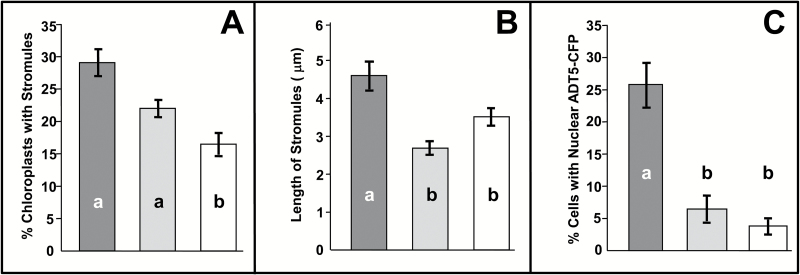Fig. 7.
The presence of ADT5 in the nucleus is affected by the ability to form stromules. To determine if nuclear localization of ADT5 is dependent on stromules, plants were co-infiltrated with TP-ADT2–CFP (A and B) as a control or ADT5–CFP (C) and an empty vector (dark gray), dominant negative myosin XI-2 (dnMyoXI-2; light gray) and myosin XI-K (dnMyoXI-K/GTD; white), respectively. (A) Percentage of chloroplasts having stromules. Chloroplasts were analyzed if they contained any visible TP-ADT2–CFP fluorescence and were determined to have a stromule if the projection was longer than 1 μm. In total 554, 395, and 579 chloroplasts were analyzed from plants transformed with an empty vector, dnMyoXI-2, and dnMyoXI-K/GTD, respectively. (B) Average length of stromules. A total of 166, 93, and 91 stromules were measured from plants transformed with an empty vector, dnMyoXI-2, and dnMyoXI-K/GTD, respectively. (C) Nuclear localization of ADT5–CFP. Cells were analyzed for CFP fluorescence in the nucleus only if any ADT5–CFP fluorescence was detectable. A total of 131, 190, and 358 cells were analyzed from plants transformed with an empty vector, dnMyoXI-2, and dnMyoXI-K/GTD, respectively. Each experiment was performed on three independent occasions. Significant differences (P<0.001) as determined by a one-way ANOVA (multiple comparisons) are indicated by different letters. Averages ± SE of the mean are plotted.

